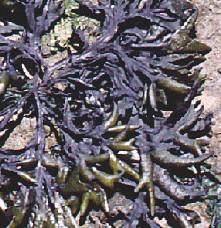







The brown "algae" are members of the kingdom-level taxon Chromista, which also includes diatoms, water molds, and coccolithophorids. This may seem surprising, since most chromists are microscopic, and are usually unicellular, but phaeophytes share many unique features with these other organisms. Like other chromists, they have two dissimilar flagella, when they have flagella at all, and they have the same pigments and photosynthates.
All photosynthetic organisms use some sort of pigment to capture the energy of light, usually some form of chlorophyll. The standard kind of chlorophyll is called chlorophyll a, and is essential for the transfer of captured light energy to molecules which will make use of that energy. Most organisms with chlorophyll have additional pigments to capture more of the light energy that they receive. In each case, however, the captured energy must be transferred to a molecule of chlorophyll a before it can be used.
 Brown "algae" and other chromists make use of several such secondary
pigments, including a modified chlorophyll called
chlorophyll c. This form of chlorophyll does not
have the long "tail" that would be present in plant chlorophylls. In addition,
phaeophytes have large amounts of carotenoids in their plastids, and
it is these brown and golden pigments which give the chromists their
characteristic color. The most important carotenoid in the phaeophytes is
fucoxanthin, which was named after the rockweed,
Fucus, pictured at left.
Brown "algae" and other chromists make use of several such secondary
pigments, including a modified chlorophyll called
chlorophyll c. This form of chlorophyll does not
have the long "tail" that would be present in plant chlorophylls. In addition,
phaeophytes have large amounts of carotenoids in their plastids, and
it is these brown and golden pigments which give the chromists their
characteristic color. The most important carotenoid in the phaeophytes is
fucoxanthin, which was named after the rockweed,
Fucus, pictured at left.
The carbon-containing products of photosynthesis are called photosynthates. In plants, these would be glucose and starch, a polymer of glucose. However, starch is not made by any chromist, but rather glucose and mannitol are polymerized together as laminarin. Mannitol is a six-carbon sugar-alcohol; it is linked together with glucose in a beta-1,3 linkage.
All this biochemistry may seem a bit esoteric, but it demonstrates that the chemical makeup of each of the various chromist groups is quite similar to the others, and that they are all quite different from the green algae and plants. This difference is not merely a superficial one -- the enzymes and biochemical reactions are different, as are the underlying genetic codes that give rise to them. In short, not all photosynthetic organisms are closely related. For a fuller understanding, take a look at this cladogram of the eukaryotes -- note especially where the red algae (Rhodophyta), green algae, and plants are with respect to the Chromista. You may notice that the animals are more closely related to the plants than the chromists are!
While their placement within the Chromista is well established, the relationship of the brown "algae" to other chromists is not well worked out. It is believed that they are most closely related to the yellow-green algae and the golden algae, but intensive work on solving this question is still being done. Neither are the relationships within the Phaeophyta agreed upon. Many genera are in need of detailed study, as there is not even agreement among experts on the number of kelp species in even the most common genera. What is agreed upon is that the "original" phaeophytes were either unicellular, or were small and composed of filaments, like the living genus Ectocarpus, and probably had a similar life cycle.
Currently, there is no general agreement as to the number of orders, but life history and morphological features are used to delimit the groups by most workers.


